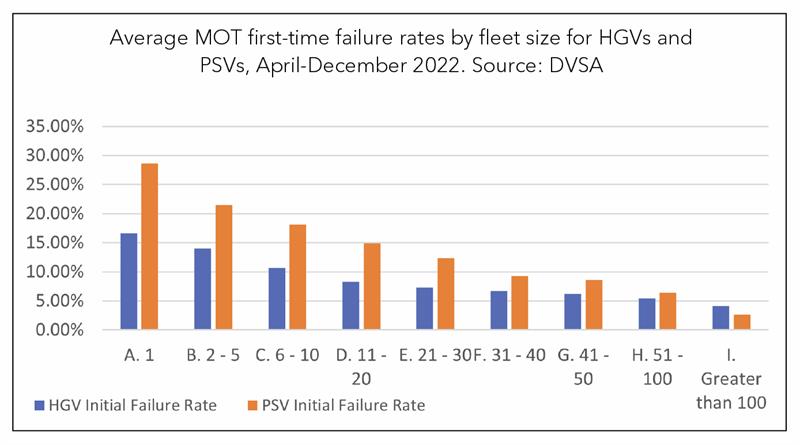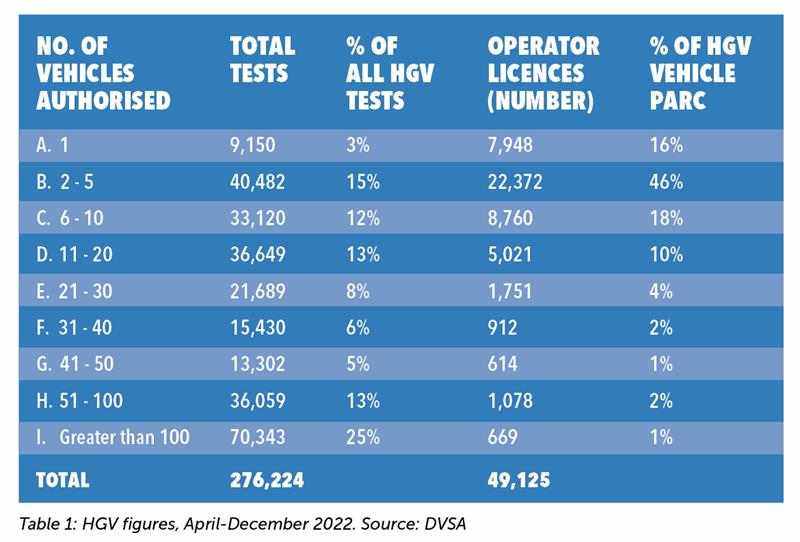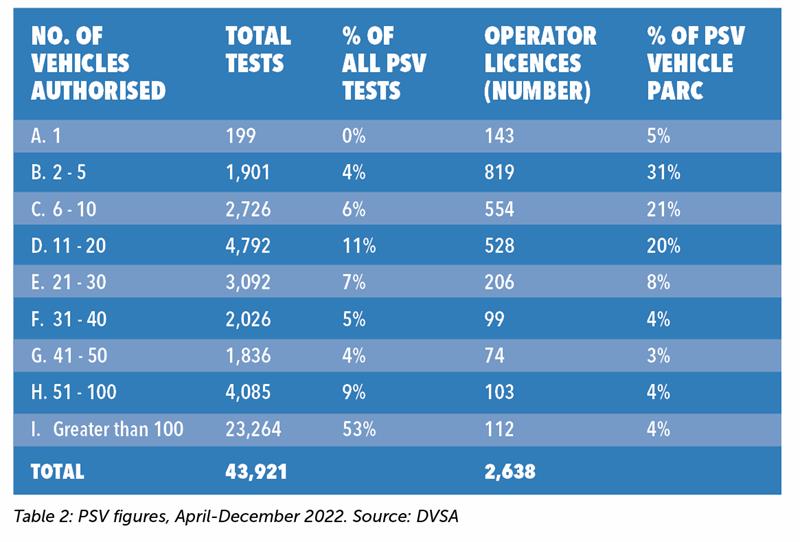Improving the first-time pass rates for commercial vehicle fleets is often viewed as the holy grail for any operator, but the latest information from DVSA might challenge how much progress is really being made. While pass rates are going up, the initial failure rates across the board of both HGVs and PSVs remain pretty high, especially among smaller fleets.
In both HGVs and PSVs, the larger the fleet, the lower the rate of failure. Across almost all sizes of fleets, the failure rates are higher for PSVs than HGVs, until the fleet size reaches above 101 vehicles. Then, while the HGV failure rate was 4.14% (70,343 tests in total) for the latest reporting period available, April-December 2022, PSVs in larger fleets of 101 or more are only failing 2.65% of the time (across 23,264 tests).
John Taylor, operational technical executive at the Confederation of Passenger Transport, says that over the past few years, there has been a gradual improvement in pass rates. “I get to see the DVSA figures on a daily basis and the overall rate is currently around 93%,” he confirms. “To us, that’s an excellent pass rate, especially when you consider that you’re always going to get problems with items such as bulbs that are out or headlamp aim fails that are affected by suspension and chassis issues. That’s a positive angle in an industry that has constantly been moving forward to try and improve performance levels.”
However, when it comes to those April to December 2022 figures, Taylor recognises that there is still work to be done, even if such issues can’t easily be fixed overnight. “Larger fleets obviously have a greater ability to achieve a first-time pass rate, thanks to more training and better facilities; they are effectively carrying out an MOT with every inspection,” he reasons. “They will put the vehicle on a roller brake tester, run headlamp aim checks, emissions testing – and all the staff will be trained to the standards that the DVSA would expect.”

Taylor also argues that larger fleets in both the HGV and PSV world would have access to inspection-accredited testers, as well as engineers that are solely employed to carry out repairs. “A smaller fleet of up to five vehicles is less likely to employ their own engineer,” he says. “They tend to use another means of inspection such as a garage, and will have less input into the repair and maintenance of their vehicle. That’s probably the case of fleets up to 50 vehicles. At that point, people will start to think about employing a mechanic, so they are more reliant on what is available in the marketplace. That’s why the larger groups are so much better, because they can control their staff – plus they are set targets for pass rates and work on KPIs, which other smaller companies might not.”

What about the discrepancy between the HGV rates and PSVs in the same vehicle bands? Taylor makes a solid defence of his industry: “In the HGV world, it’s different, because a lot more of the vehicles are bought on lease with a contract maintenance agreement. Also, because operators tend to have the vehicles for a shorter length of time – seven years, instead of our 15, for example – they tend to use dealerships more for doing their inspection and repair work and MOT preparation and presentation. For the bus and coach world, much more of that is done in-house.”
Inspection times also come into play when trying to justify the difference in pass rates, believes Taylor. “The inspection cycles might be shorter on a PSV-type operation. You tend to find bus and coach operators inspect their vehicles between six to 12 weeks, whereas trucks can be anything up to 17 weeks,” he says.

BODY ISSUES
Andrew Warrender, RHA’s operations manager – coach sector, admits that he hadn’t noticed the differences between PSV and HGV before, but reckons it can be explained by body issues, rather than mechanical ones. “Mechanical items are pretty much common with trucks, so I’d expect a degree of commonality with any reasons for failure there,” he says. “The larger fleets fare better, most of which is likely to be the result of more intense maintenance regimes – any fleet with 100 vehicles-plus will be a bus operator and its vehicles are used more intensively so require more closer inspection. Another reason may be that most smaller fleets are coach operators and, as PSVs are invariably more complex than HGVs (and coaches the most complex of all) they’ll have more things likely to result in failure,” he says, qualifying his remarks however with the comment that it’s hard to draw conclusions without knowing the specific items that most commonly result in failure.
Although he acknowledges the importance of keeping a PSV up to test standard every time it goes out, he observes that there some very fragile items onboard that can be “a pain for operators” to deal with. “Seatbelts are very temperamental – reel springs often seem like they are made of chocolate and lock at will when being pulled out. Testers will invariably fail that item if it doesn’t come out cleanly first time. Door mechanisms are notoriously temperamental (many will refuse to open or close, or both, if the coach is on a gradient), all of which have potential to result in failure.
“The move towards accessibility has had an impact on maintenance,” he continues. "Lifts and ramps are very needy, they have sensors for interlocks with very fine tolerances, but are fitted to equipment with very coarse tolerances resulting in poor reliability. Travel on any accessible coach and its impossible not to notice the rattling lift under the floor.”
The CPT is just one organisation looking to make a difference when it comes to helping fleets improve on their first-time pass rates. “We have engineering forums where we cover best practice and distribute best practice out to members. Within the forums, we have people from DVSA present, as well as engineers and technicians from small and large operators – whether you’ve got one vehicle or 1,000.”
When it comes to the wider industry, Taylor believes a greater emphasis on training could further improve pass rate figures. “It’s important to understand the benefits of training and also the need for best practice,” he reasons. “I’ve been a member of SOE since I was 20. And being a part of a society such as the SOE helps you keep up to date with the latest industry skills and knowledge. Transport Engineer also provides really important information and knowledge, as well as details of new guides that have been introduced or are in progress. All of that can make a difference and help to improve people’s understanding of what the issues are, the challenges we face and how those issues and challenges can be overcome.”